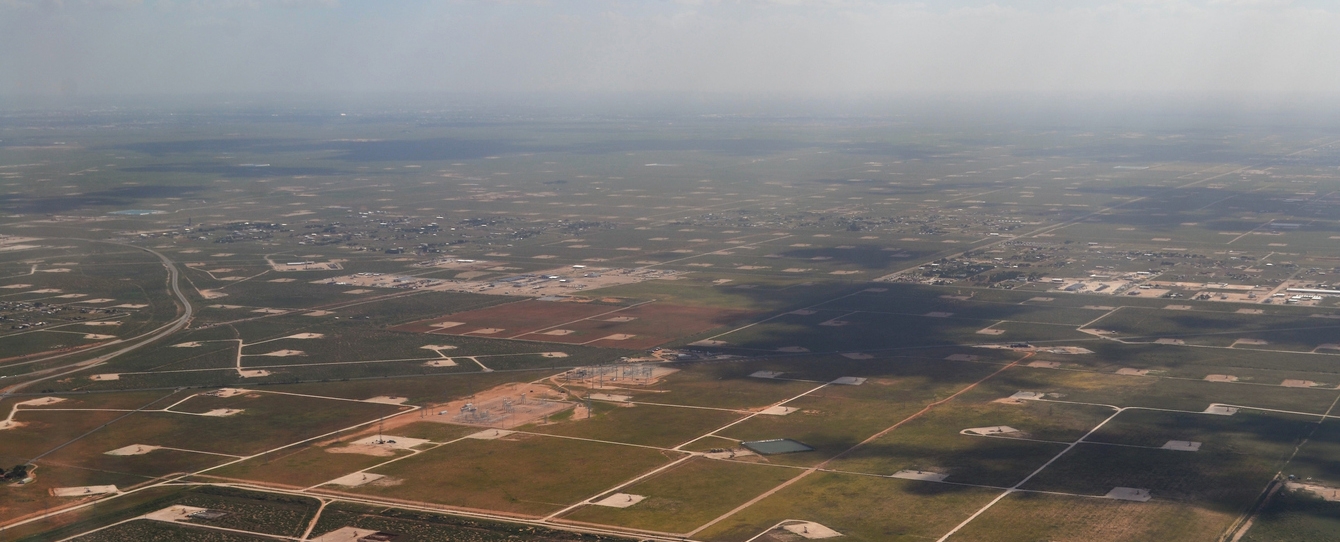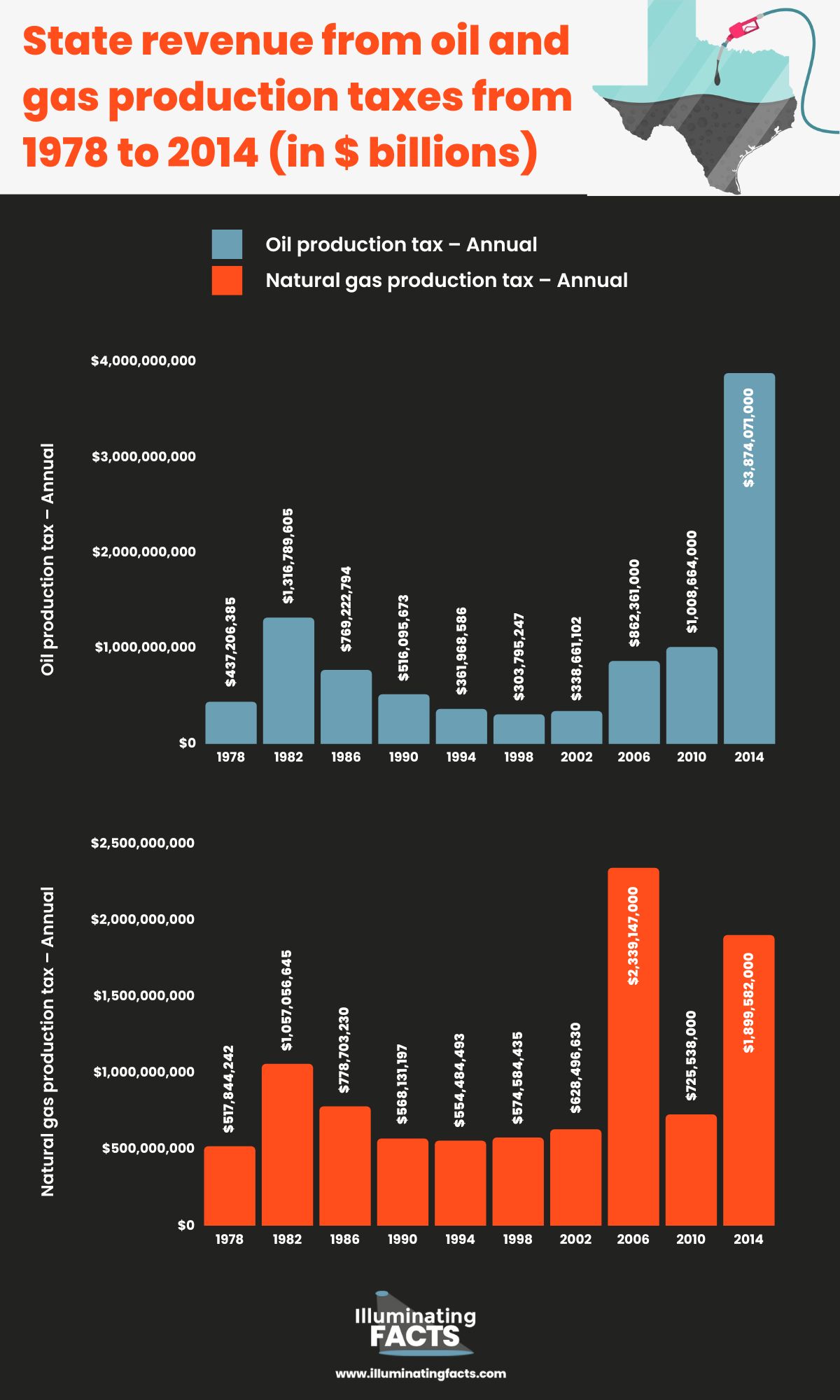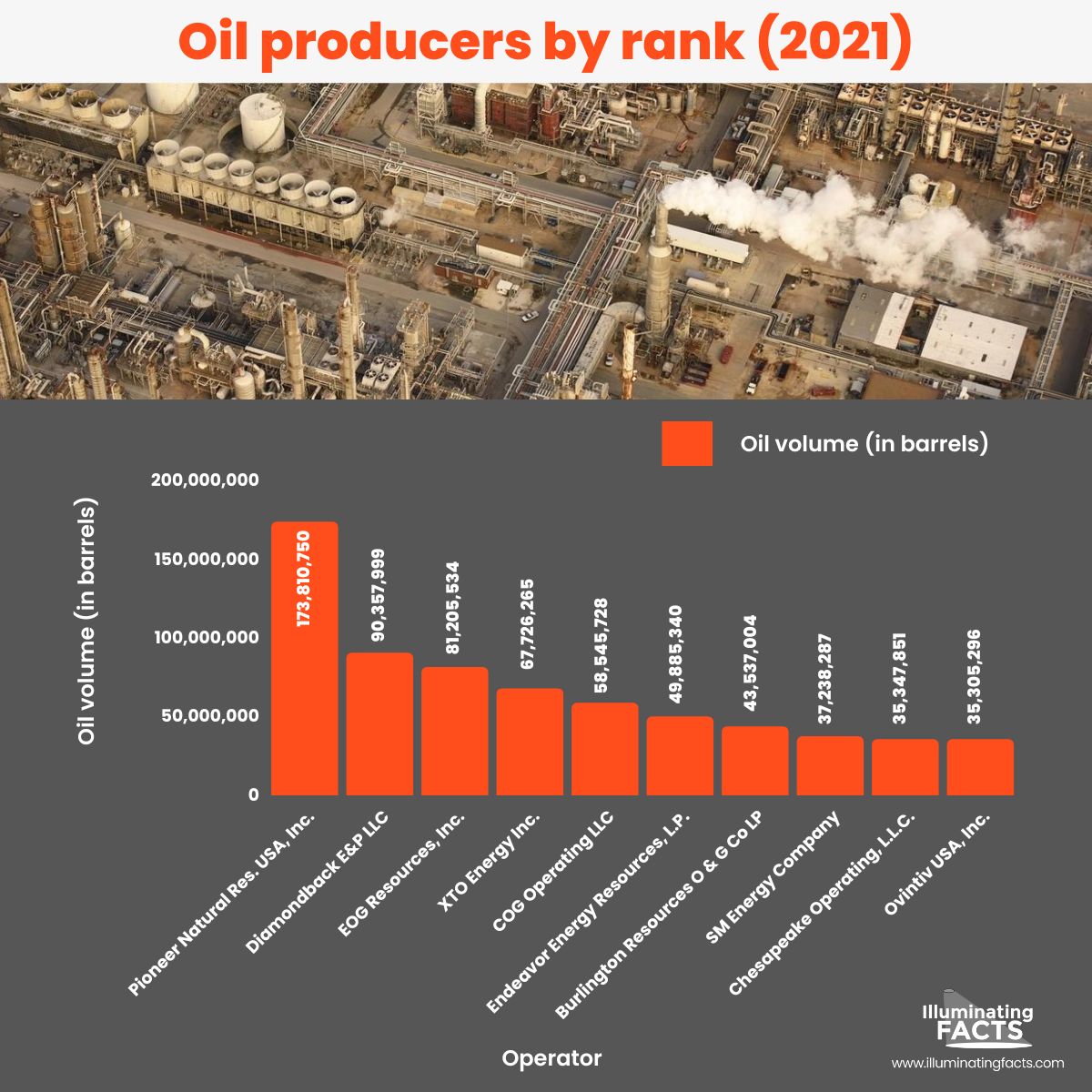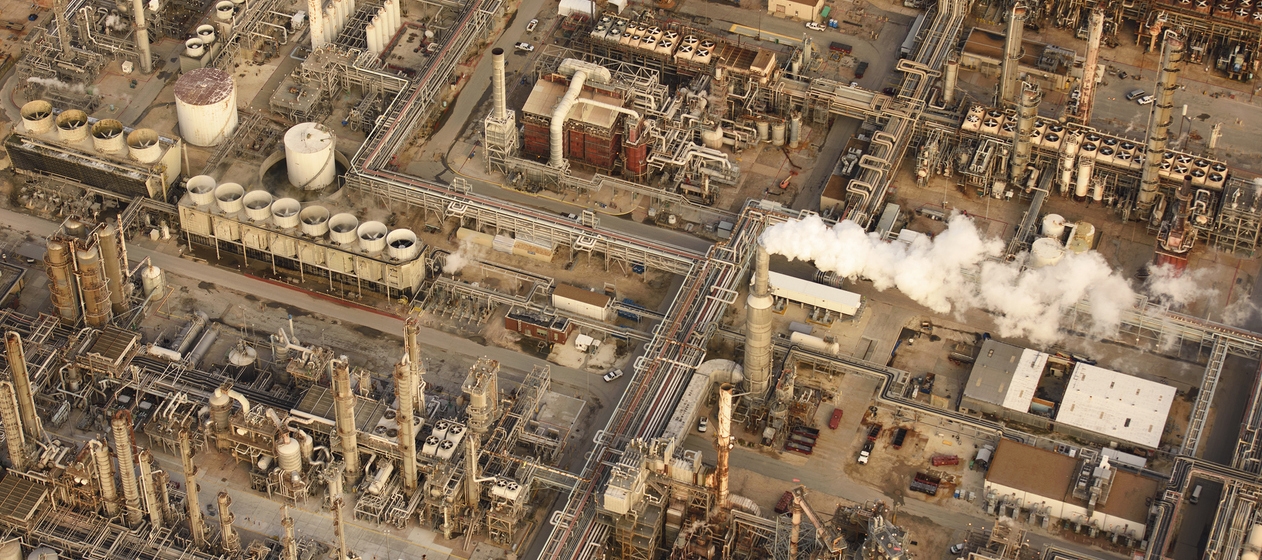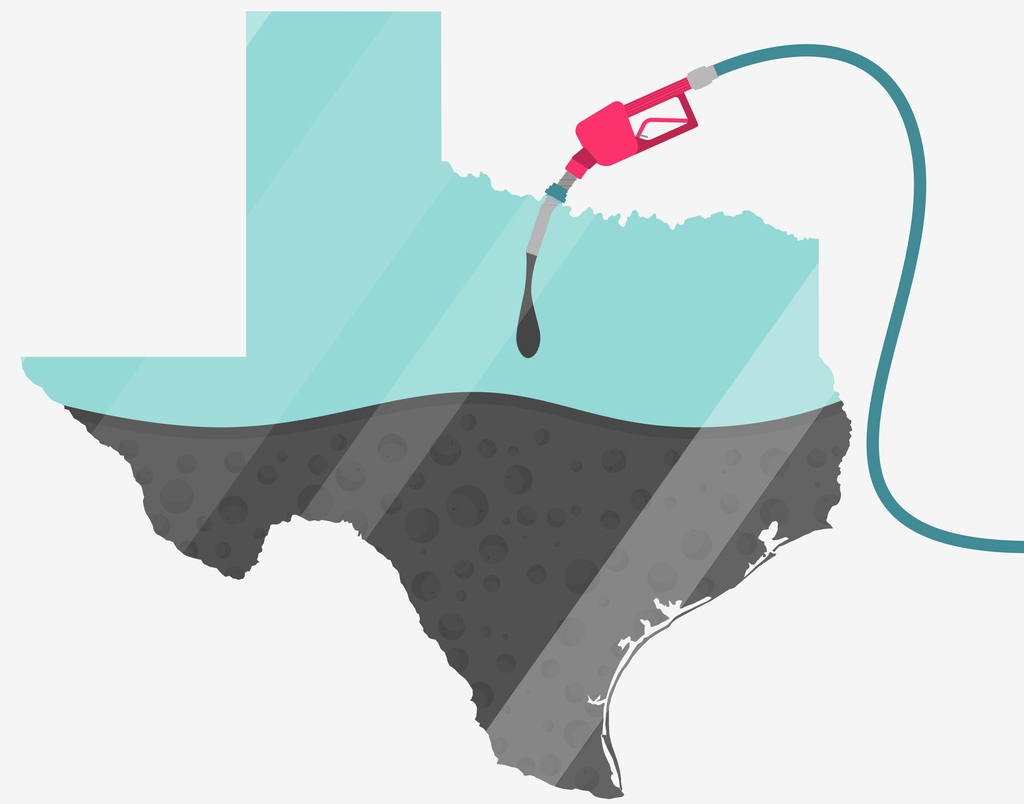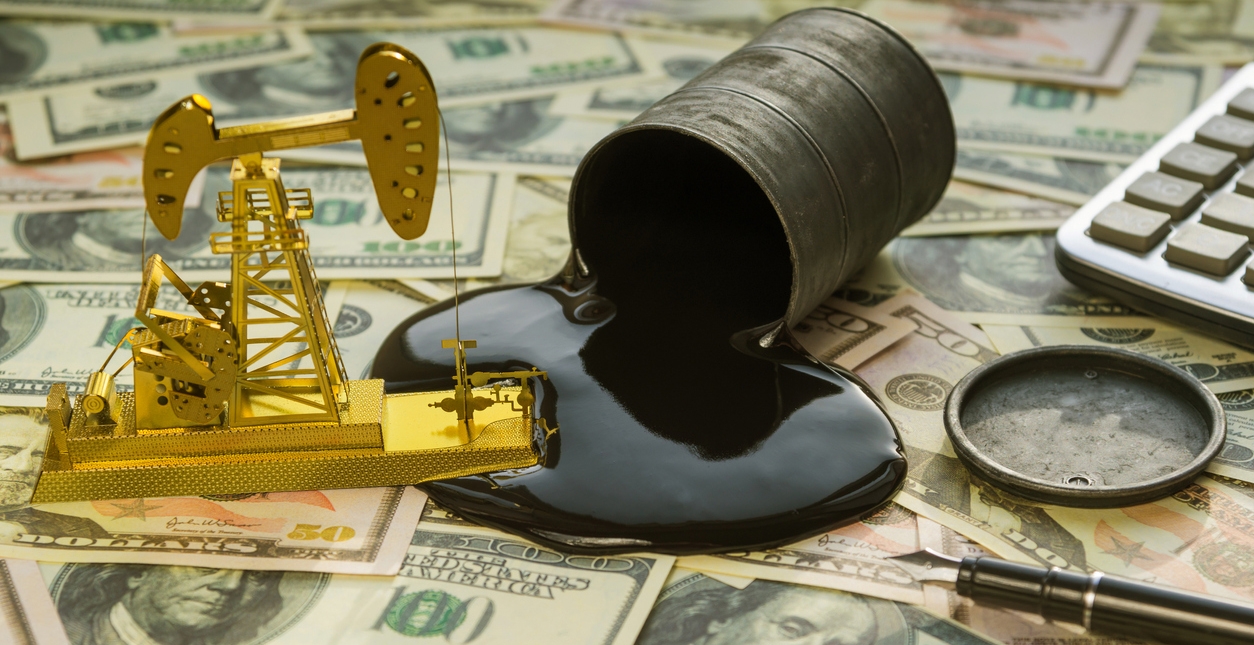Until the arrival of the “big tech” and other industries, oil had been the top cash cow in the state of Texas for many decades since the beginning of the “oil boom” in the early 20th century. However, oil is no longer the predominant force behind Texas’ economic development. In addition, the state’s energy industry is facing a continuously evolving transition from CO2-emitting fossil fuels to renewable and “green” resources. Still, oil remains one of the Lone Star State’s biggest and most profitable industries.
More than its economic significance, oil has also impacted Texas’ society and culture. It continues to provide benefits to Texas residents as well as to people throughout the United States.
The short history of the Texas oil industry
The story of oil in Texas began even long before the legendary Spindletop gusher in the early 20th century.
Oil was first discovered in what is now today Texas in July 1543 when Spanish explorer Luis de Moscoso Alvarado of the DeSoto expedition noticed oil floating on the waters of Galveston Bay in the region between High Island and the Sabine Pass. The group used the oil to caulk their boats. [1] However, the economic significance of oil did not happen for another three centuries.
The drilling of the first wells
You may have known the oft-repeated story of the famous gusher at Spindletop in 1901. While it was indeed the first major oil discovery in Texas, it wasn’t the first in the state.
The first oil well in Texas was drilled in the small town of Nacogdoches in 1859, although it was never as well-known as Spindletop.
In 1894, the town of Corsicana, Navarro County, was running out of water. The town leaders hired a contractor to drill a water well. At a depth of 1,035 feet, what the driller found was not water, but oil. Thus, this accidental discovery started the first oil boom in Texas. By 1900, Corsicana had brought in 839,000 barrels of oil. [2]
While the Corsicana oil discovery was significant in bringing Texas into the nationwide oil industry, no discovery had as monumental an impact on the state’s oil production than the Spindletop gusher, which took place on January 10, 1901. A mining engineer, Anthony F. Lucas, drilled the oil well at Spindletop, a small hill located south of Beaumont. The Spindletop gusher exceeded 17 million barrels of oil, dwarfing the Corsicana production in 1900. This phenomenal discovery prompted hundreds of businessmen and speculators to flood the area to try their luck at finding the “black gold.”
The Texas oil industry: a boon and a bane
Within a year of the Spindletop discovery, over 500 oil companies were operating at Spindletop alone, including Texaco, Magnolia Petroleum Oil Company, Gulf Oil Corporation, and Exxon. The success at Spindletop prompted other oil companies to explore for possible oil finds, similar to the famous gusher, along the Gulf Coast.
The first offshore drilling occurred in 1908, in northern Galveston Bay, where the Goose Creek Oil Field was discovered. Several other drillings followed, but most of them ended up with dry holes, and the field was abandoned. However, a gusher in 1916 created the first real boom there.
The arrival of the railroad in the late 19th century accelerated the boom in agriculture in Texas. But following the Spindletop gusher at the turn of the century, agriculture began to be quickly replaced by the oil or petroleum industry.
By the 1920s, the railroads’ chief source of revenue out of Texas was from oil and gas production. Up to now, tanker cars continue to drive in and out of Texas via extensive railroad systems plying across the state and leading to multiple refineries.
Throughout the 20th century, the oil industry in Texas expanded throughout the other parts of the state. The Eagle Ford (located in southern Texas) and the Permian Basin (located in western Texas and southeastern New Mexico) are two of the biggest oil and gas producing regions in Texas, dominating the country’s crude oil production.
Texas is the top crude oil producer in the US, holding around 43% of the country’s crude oil production. In addition, Texas is the leading natural gas producer in the US, accounting for 25% of the country’s natural gas reserves (as of 2021). [3] As long as there are liquid treasures under the Texan earth, the Lone Star State will continue to be the country’s leading top crude oil and natural gas producer.
The oil industry in Texas has provided economic benefits as well as job and educational opportunities for its millions of citizens. It is responsible for around 2.5 million jobs in Texas. However, the Texas oil industry is not without its share of setbacks and disasters, most of which are environmental. You will find more about it in this article.
The Texas oil boom peaked in 1972 where drillers pumped approximately 3.4 million barrels per day on average from the Lone Star State’s oil fields. However, production dwindled through the late 1990s and early 2000s.
In 2019, Texas rolled out 1.85 billion barrels of oil across the state, marking the highest year of oil production in the history of the American oil industry. In 2020, the Energy Information Administration (EIA) reported that the national crude oil production grew by 11% in 2019, with 12.23 million barrels of oil per day.
Top oil plays and fields in Texas
When people say, “everything is bigger in Texas,” they’re not kidding. There’s the land size (the biggest state in the US mainland and second-biggest only to Alaska in terms of land size), the massive population, and those juicy and enormous Texas BBQs. The same thing can be said about Texas’ oil production. The Lone Star State has produced more oil and natural gas than any other state and remains the biggest daily producer of such commodities.
No other state or region in the US, and even worldwide, has been as heavily exploited or drilled for oil and natural gas as Texas.
Shale play is defined as an area with layers and layers of fine-grained sedimentary rock formed from the compaction of silt and clay. Shale, mainly black shale, contains organic matter that can produce oil and natural gas.
For Texas, extracting that much oil and natural gas output is a combination of legacy oil fields and recently discovered shale plays, particularly those in the Permian Basin in western Texas, [4] which alone accounts for 14% the total oil production in the US.
- Permian Basin – Located in western Texas and southeastern New Mexico, the Permian Basin is one of the largest shale plays in the United States. This sprawling shale patch is home to over 7,000 oil fields in west Texas. It produces five billion cubic feet of natural gas per day and 1.3 million barrels of oil per day. The Permian Basin is one of the oldest oil and natural gas producing regions; drilling in this area actually began in the 1920s. With the advent of newer drilling technologies available for both oil and natural gas, companies drilling in the Permian Basin will be able to obtain more from their efforts.
- Eagle Ford – Eagle Ford, located in southern Texas, is one of the largest shale plays in the US, covering over 3,000 square miles. It was discovered pretty recently, in 2008. Eagle Ford produces six billion cubic feet of natural gas per day and around 1.2 million barrels of oil per day. Four companies comprise 45% of the drilling in Eagle Ford.
- Barnett – The Barnett shale play lies beneath the city of Fort Worth and at least 17 counties, covering over 5,000 square miles. Barnett is difficult to extract compared to Permian Basin, Eagle Ford, and other plays since the rock and sand are wrapped around the hydrocarbon deposits. But thanks to advanced technologies, such as horizontal drilling and hydraulic fracturing, drillers are able to get more resources than ever – they can even extract as much as 4.5 billion cubic feet of natural gas per day and 15,500 barrels of crude oil each day.
- East Texas Oil Field – This sprawling oil and gas field in east Texas is the second-largest oil field in the continental US. Since its discovery in 1930, some 30,340 historic and active wells have been drilled within 140,000 acres (57,000 hectares) to produce around 5.42 billion barrels of crude oil. This oil field covers parts of five counties – some areas in Gregg, western Rusk, southern Upshur, southeastern Smith, and northeastern Cherokee counties in northeastern Texas. East Texas Oil Field’s sheer quantity of oil and significance during World War II resulted in the construction of the Big Inch, a 24-inch, 1,400-mile pipeline [5] that served refineries as far as Philadelphia and New York; the pipeline was completed in 1944. The oil field’s economic and historical significance is crucial to the impact of petroleum on Texas’ economy and the development of Texas as a state abundant in energy resources.
Texas oil production
Note: This chart displays initially reported production for both onshore and offshore wells. The initially reported production volumes are subject to change as additional late reports or corrections are obtained.
(Data source: Railroad Commission of Texas – https://www.rrc.texas.gov/oil-and-gas/research-and-statistics/production-data/historical-production-data/crude-oil-production-and-well-counts-since-1935/)
State revenue from oil and gas production taxes (1978 – 2014)
State revenue from oil and gas production taxes from 1978 to 2014 (in $ billions) |
||
| Year | Oil production tax – Annual | Natural gas production tax – Annual |
| 1978 | 437,206,385 | 517,844,242 |
| 1982 | 1,316,789,605 | 1,057,056,645 |
| 1986 | 769,222,794 | 778,703,230 |
| 1990 | 516,095,673 | 568,131,197 |
| 1994 | 361,968,586 | 554,484,493 |
| 1998 | 303,795,247 | 574,584,435 |
| 2002 | 338,661,102 | 628,496,630 |
| 2006 | 862,361,000 | 2,339,147,000 |
| 2010 | 1,008,664,000 | 725,538,000 |
| 2014 | 3,874,071,000 | 1,899,582,000 |
(Data source: “Texas Budget Revenues | Oil and gas production taxes” (published on October 1, 2019) – https://knoema.com/infographics/ymmsndb/texas-budget-revenues-oil-and-gas-production-taxes)
Largest oil producers in Texas
Below is a table of the state’s largest oil producers as of 2017
Texas oil producers by rank (as of 2017) | ||||
Oil volume rank | Company | Annual oil production | Daily production average (in barrels) | % of Texas production |
1 | EOG Resources, Inc. | 92,685,342 | 253,932 | 9.027 |
2 | Pioneer Natural Res. USA, Inc. | 73,474,423 | 201,300 | 7.156 |
3 | Occidental Permian, Ltd. | 39,596,686 | 108,484 | 3.854 |
4 | Chesapeake Operating, LLC | 33,623,222 | 92,118 | 3.275 |
5 | COG Operating LLC | 33,346,066 | 91,359 | 3.248 |
6 | XTO Energy Inc. | 32,987,782 | 90,377 | 3.213 |
7 | Devon Energy Production Co., LP | 28,963,072 | 79,351 | 2.821 |
8 | Apache Corporation | 28,156,895 | 77,142 | 2.742 |
9 | Encana Oil & Gas (USA) Inc. | 27,620,274 | 75,672 | 2.69 |
10 | Marathon Oil EF LLC | 26,771,371 | 73,346 | 2.607 |
(Data source: https://www.bizjournals.com/dallas/news/2018/03/28/well-well-well-measuring-a-year-of-oil-production.html)
Below is a table of the largest oil producers in Texas for the calendar year 2021. The oil volume includes the combination of both oil and condensate (light liquid hydrocarbons) volume.
Oil producers by rank (2021) |
||
| Oil volume rank | Operator | Oil volume (in barrels) |
| 1 | Pioneer Natural Res. USA, Inc. | 173,810,750 |
| 2 | Diamondback E&P LLC | 90,357,999 |
| 3 | EOG Resources, Inc. | 81,205,534 |
| 4 | XTO Energy Inc. | 67,726,265 |
| 5 | COG Operating LLC | 58,545,728 |
| 6 | Endeavor Energy Resources, L.P. | 49,885,340 |
| 7 | Burlington Resources O & G Co LP | 43,537,004 |
| 8 | SM Energy Company | 37,238,287 |
| 9 | Chesapeake Operating, L.L.C. | 35,347,851 |
| 10 | Ovintiv USA, Inc. | 35,305,296 |
(Data source: https://www.rrc.texas.gov/oil-and-gas/research-and-statistics/operator-information/texas-oil-and-gas-producers-by-rank-2021/)
Top “oil towns” in Texas
Houston – It seems that almost all of the superlatives come from the city of Houston in terms of land area, population, and also, oil production. As the “Energy Capital of the World,” Houston is home to several oil and gas companies. The top oil players in Houston’s Energy Corridor include Shell, ConocoPhillips, and BP. Phillips 66, the second-biggest public company in Texas, brought in $111.5 billion in revenue for 2018. Oilfield services behemoth Schlumberger Ltd. also operates in Houston.
Austin – The capital of Texas, Austin has also benefited handsomely from the oil boom. It is now home to over 300 companies, including Jones Energy and Brigham Exploration, employing thousands of Texans in the oil investment field, surveying, drilling, and production. Helping the oil drilling activities is access to the alumni and research facilities at the University of Texas at Austin. UT Austin’s Petroleum and Geosystems Engineering department has provided an educational foundation for oil companies to be further equipped with the latest technologies in the oil field.
Dallas – Once the rail and cotton hub, Dallas’ industry and economy changed dramatically, thanks to the oil boom. Oil tycoon H.L. Hunt lived in Dallas and left an enduring legacy. Dallas is home to the headquarters of multi-billion energy companies Energy Transfer LP and HollyFrontier Corporation.
San Antonio – As the second most populous city in Texas, San Antonio is home to around 80 oil and gas companies, including Valero Energy. The Fortune 500 company brought in $108 billion in 2019 but only $64 million in 2020. San Antonio also hosts the annual South Texas Oilfield Expo. The Ultramar Diamond Shamrock Corporation is an oil refinery owned and operated by Valero and one of the city’s biggest employers.
Midland – Midland’s location in the Permian Basin gives the city a significant economic advantage. Midland’s population and average salaries have increased substantially since gains were first made from oil drilling. The wealth that oil brings to the city has driven population growth; in 2018, Midland reportedly experienced the biggest population swell in the country. Average wages have increased throughout the city, including wages for entry-level fast-food service employees. Other employees and professionals, including teachers, leave their jobs to seek higher-paying opportunities in the oil sector, where inexperienced workers have the chance to earn as much as $70,000 or perhaps even more.
How has the oil industry affected Texas?
First, here is a handful of facts about the oil industry in Texas
- Texas is the top oil- and natural gas-producing state in the US, accounting for 43% of the country’s oil production and 25% of its natural gas production.
- As of May 2022, there are 31 oil refineries in Texas, many of which are clumped near major seaports along the Gulf Coast, mostly in the Houston area.
- Texans affectionately call crude oil “black gold.” Oil is also referred to as “Texas tea.”
- Texas’ oil and natural gas industry supports a total of 2.5 million jobs statewide as of 2019.
- The oil well in the small city of Nacogdoches, in Nacogdoches County, east Texas, remains the state’s first and oldest oilfield. [6] First operated in 1859, the oil well’s production history reached well into the 1950s.
The oil industry has significantly shaped the Lone Star State in many aspects.
Economy
Since the oil boom began in the early 20th century, the oil and gas industry has been a cornerstone of Texas’ economy. It helped hasten the industrialization in Texas. The state’s oil-rich regions and nearby states saw a significant increase in employment in other industries, such as mining, manufacturing, transportation, and services. The oil and gas industry is responsible for around 2.5 million jobs in Texas. As a result of the substantial and long-lasting effects that oil and gas have brought to Texas, wages and incomes have increased significantly. The oil and gas industry has also helped promote other industries in Texas, varying from lumber to railroads to construction and real estate.
The widespread production of oil and gas in Texas has globalized the state’s economy and changed its primary industry.
In 2021, Texas ranked as the top state with the highest share of the country’s total economic contributions by the oil and natural gas supply.
According to the findings by professional services firm PricewaterhouseCoopers in 2019, Texas’ oil and natural gas industry has directly and indirectly:
- Provided 2,508,870 total jobs (620,330 direct and 1,888,540 indirect jobs) or 13.9% of the total employment in Texas.
- Created additional 3% jobs elsewhere in the Texas economy for every direct job in the state’s oil and natural gas industry.
- Brought in $251.2 billion ($143.3 billion direct and $116.9 billion indirect income), or 21.8% of the state’s total labor income.
- Contributed $411.6 billion to the state’s gross domestic product (GDP). [7]
Education
Education in Texas has also significantly benefited from the oil and gas industry. Many universities and other educational institutions in Texas have been able to benefit from the state-sponsored oil production, plus donations from wealthy investors (including oil magnates, of course), which fuel substantial growth, improvement, and development in their campuses. Primary and secondary education also improved significantly from the oil bonanza, even though the extreme growth in some new boomtowns initially caused severe pressure on school systems, which were not yet prepared to receive the influx of students.
Billions of dollars from Texas’ oil and natural gas activity go into the state’s educational funds. Schools, colleges, universities, and counties benefit directly from the oil and natural gas royalties, which are deposited into the Permanent School Fund (PSF) and Permanent University Fund (PUF) every year. Both the PSF and PUF widely support public education in Texas. [8]
Society and culture
Oil and gas production has also profoundly impacted the society and culture in Texas. The famous gusher at Spindletop and subsequent major oil discoveries and drilling prompted prospectors, investors, businessmen, laborers and their families, and anyone else searching for a better life to flock to Texas to hit the “oil strike” big-time. As a result, it has driven significant population growth and dramatically changed the state’s urban landscape.
Because oil and gas were abundant in Texas (and they still are), they were obviously inexpensive and readily available. The early years of the Texas oil industry also led to the budding development of the automobile industry. In fact, Houston launched the car culture in the early 20th century as the role of automobiles became increasingly significant. More and more Texans bought, owned, and drove cars. By the 1920s, the traffic problem in Texas had become so severe that it prompted the state to install traffic lights, the first in the country.
As automobiles became more common, more roads, highways, and expressways began to be constructed across the state. The oil industry also led to the rapid mechanization of farm work, enabling farmers to produce more crops without needing more human workers. Manufacturing plants and facilities began to spread quickly across Texas, using cheap oil as fuel.
One of the indirect effects of the prosperous oil industry in Texas is the development of the state’s art and culture. Many of these oil tycoons have supported fine arts, music, and literature. Everette Lee DeGolyer, an oil executive from Dallas known for his active role in petroleum exploration and production, supported the Dallas Symphony Orchestra and other musical groups based in the city. In addition, DeGolyer was a rare book collector; he later donated 89,000 volumes of his personal book collection to college and university libraries.
Dominique Schlumberger de Menil, whose father founded the Schlumberger oilfield services firm, collected around 10,000 artworks. She and her husband, John de Menil, founded the Menil Foundation in Houston to house their art collection.
The daughters of Joseph S. Cullinan, the founder of the oil firm Texaco, supported arts in Houston, including the Houston Symphony, Houston Museum of Fine Arts, and Houston Ballet. The Houston Museum of Fine Arts continues to receive a large part of its endowment from philanthropy, mostly by individuals and companies associated with the oil and energy industry.
Environment
While the oil industry brings a positive impact to the Texas economy, education, infrastructure, etc., it also brings adverse effects, especially to the environment. Indeed, the oil industry is a dirty business.
Since the oil boom, the industry has contributed to the state’s environmental degradation. Oil and natural gas drilling has a serious impact on Texas’ wildlands and communities. Oil drilling alone has contributed to significant pollution, climate change, disruption to wildlife habitat, significant loss of life or lifelong injury to creatures, and damage to public lands set aside to benefit communities.
Early on, the oil boom created some severe negative consequences on the environment. There were efforts to conserve and protect the environment, but these efforts ended up unsuccessfully due to the ease of finding oil during the early decades. The rush and excitement to strike it rich from the oilfields caused severe repercussions to the environment. Poorly constructed storage facilities led to leaks, causing serious pollution to land and water. The clearing of fields for oil exploration and drilling caused the destruction of dense forests, fields, and ranchlands in the state.
Fast forward to 2010 – a faulty blowout preventer on a British Petroleum (BP) deep-water rig in the Gulf of Mexico caused an explosion, leading to a marine oil spill – the largest ever in the history of the petroleum industry. The disaster killed 11 people and injured 17, not to mention causing massive damage to marine life. Subsequently, BP and its partners faced a lawsuit from the US Department of Justice, citing economic and environmental damage.
Not surprisingly, oil producers in Texas are not spared from the criticisms by several environmental groups. In 2011, the US Fish and Wildlife Service considered a proposal to include the dunes sagebrush lizard on the “endangered species” list. [9] The environmental agency crossed swords with several oil companies, who argued that protecting the dunes to conserve the lizards’ population would cause the shutdown or even significant interruption in the oil production. ExxonMobil was also involved in a lawsuit with the Sierra Club and Environment Texas for violating the Clean Air Act at its chemical plant and refinery in the city of Baytown.
Poorly regulated or unregulated industrial activities caused significant air pollution. Gas flares seen in new oil fields were becoming more common, thus making the problem even worse. As Houston emerged as the most industrialized area in Texas, it also became a hotbed of air pollution due to severe air quality issues. Although air quality in urban areas has somewhat improved in recent years, as of 2015, Texas is still the number one producer of greenhouse gases in the US. In 2017, NASA ranked Houston as having the worst air quality in the country, although other entities placed the city in better rankings.
The toxic air pollution surrounding the Houston Ship Channel is one of the worst cases of air quality degradation in Texas. Houston produces a quarter of gasoline in the entire US. Not surprisingly, the serious air pollution in the area has raised numerous health issues. In 2021, the Houston Health Department discovered high levels of formaldehyde in neighborhoods along the Houston Ship Channel. Formaldehyde is a toxic chemical that can cause cancer in humans, especially when exposed frequently to it.
This is the not-so-pretty side of the energy situation in Texas. But on the other side, Texas is also emerging in the “green” energy field. In fact, The Lone Star State is the undisputed leader in renewable energy in the country. The US Energy Information Administration reports that Texas generates more than 6.5 million megawatt hours of electricity from renewable resources. [10] And Texas, being a vast state, has an abundance of renewable energy resources – wind, solar, geothermal, and biomass. But can renewable energy soon replace traditional energy resources (oil, gas, and coal) in Texas? Only time can tell.
Conclusion
The oil boom in the early 1900s dramatically changed Texas’ economic, industrial, social, and cultural landscape in a 360-degree way. Like the California Gold Rush in the mid- to late-19th century, the Texas oil bounty set off a frenzied rush as hopeful prospectors flocked to Texas. This led to the proliferation of oil fields, and even up to now companies continue to exploit them at the expense of the environment.
Although oil and natural gas no longer dominate the Texas economy as they did before, they are still significant contributors to the state’s economy, employment, and tax revenue. The oil bounty helped revolutionize Texas’ transportation and industry. Up to now, oil has brought in several billions of dollars to the Lone Star State, leading to improvements in infrastructure, education, and other services. Several sectors and fields, such as the arts and culture, have also benefited from the oil boom, albeit indirectly.
Since the oil boom over a century ago, the “black gold” has been an intrinsic part of Texan life and culture. You might say that “Texas” has been synonymous with “oil.”
But with the growing health and environmental concerns as well as the emergence of renewable energy in the state – are fossil fuels, such as oil and gas, on the way out in Texas? From the looks of it right now, this is still far from happening.
References
[1] “Oil and Texas: A Cultural History.” Texas Almanac, not dated. Available on: https://www.texasalmanac.com/articles/oil-and-texas-a-cultural-history [accessed on September 6, 2022]
[2] “Corsicana: Accidental Birthplace of the OIl Industry.” Bullock Museum, not dated. Available on: https://www.thestoryoftexas.com/discover/texas-story-project/corsicana-oil-navarro-county [accessed on September 6, 2022]
[3] US Energy Information Administration. Available on: https://www.eia.gov/state/print.php?sid=TX [accessed on September 6, 2022]
[4] Matthew DiLallo, 2017. “The Biggest Texas Oil Fields Producing Today.” The Motley Fool. Available on: https://www.fool.com/investing/2017/03/31/the-biggest-texas-oil-fields-producing-today.aspx [accessed on September 6, 2022]
[5] Mark E. Dixon, 2011. “Big Inch: The Local Oil Pipeline That Lead to World War II Victory.” Available on: https://mainlinetoday.com/life-style/big-inch-the-local-oil-pipeline-that-lead-to-world-war-ii-victory/ [accessed September 6, 2022]
[6] “First Texas Oil Well.” American Oil & Gas Historical Society. Archived from the original on January 20, 2016. https://aoghs.org/petroleum-pioneers/first-texas-oil-well/ [accessed on September 6, 2022]
[7] “New Analysis: Texas-Made Natural Gas and Oil Drives U.S. Economic Recovery, Strengthens All Industries.” American Petroleum Institute, 2021. Available on: https://www.api.org/news-policy-and-issues/news/2021/07/20/texas-pwc#:~:text=Texas%20ranked%20as%20the%20state,added%20to%20total%20labor%20income. [accessed on September 6, 2022]
[8] “Fueling the Future.” Texas Oil & Gas Association, not dated. Available on: https://www.txoga.org/our-industry/fueling-the-future/ [accessed on September 6, 2022]
[9] “U.S. Fish and Wildlife Service to Consider Endangered Listing for Dunes Sagebrush Lizard.” Center for Biological Diversity, 2020. Available on: https://biologicaldiversity.org/w/news/press-releases/trump-administration-consider-endangered-listing-dunes-sagebrush-lizard-2020-04-30/ [accessed September 6, 2022]
[10] “Texas trumps all as the best state for renewable energy.” Save On Energy, undated. Available on: https://www.saveonenergy.com/green-energy/texas-leads-in-renewable-energy/ [accessed September 6, 2022]


